
China, officially the People's Republic of China (PRC), is a country in East Asia. With a population exceeding 1.4 billion, it is the second-most populous country after India, representing 17.4% of the world population. China spans the equivalent of five time zones and borders fourteen countries by land across an area of nearly 9.6 million square kilometers (3,700,000 sq mi), making it the third-largest country by total land area. The country is divided into 33 province-level divisions: 22 provinces, five autonomous regions, four municipalities, and two semi-autonomous special administrative regions. Beijing is the country's capital, while Shanghai is its most populous city by urban area and largest financial center.

The Indomalayan realm is one of the eight biogeographic realms. It extends across most of South and Southeast Asia and into the southern parts of East Asia.

Wisteria is a genus of flowering plants in the legume family, Fabaceae (Leguminosae). The genus includes four species of woody twining vines that are native to China, Japan, Korea, Vietnam, southern Canada, the Eastern United States, and north of Iran. They were later introduced to France, Germany and various other countries in Europe. Some species are popular ornamental plants. The genus name is also used as the English name, and may then be spelt 'wistaria'. In some countries in Western and Central Europe, Wisteria is also known by a variant spelling of the genus in which species were formerly placed, Glycine. Examples include the French glycines, the German Glyzinie, and the Polish glicynia.
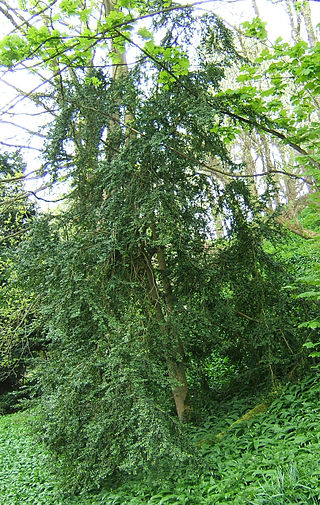
Buxus is a genus of about seventy species in the family Buxaceae. Common names include box and boxwood.

Cercis is a genus of about 10 species in the subfamily Cercidoideae of the pea family Fabaceae. It contains small deciduous trees or large shrubs commonly known as redbuds in the USA. They are characterised by simple, rounded to heart-shaped leaves and pinkish-red flowers borne in the early spring on bare leafless shoots, on both branches and trunk ("cauliflory"). The genus contains ten species, native to warm temperate regions of North America, southern Europe, western and central Asia, and China.

Dian Lake, also known as Dianchi, Dianchi Lake, Lake Dian and Kunming Lake, is a fault lake located on the Puduhe-Xishan fault in Kunming, Yunnan, China at 24°23′–26°22′ N, 102°10′–103°40′ E. Its nickname is the "Sparkling Pearl Embedded in a Highland". It is the model for the Kunming Lake in Beijing's Summer Palace. Its name is the source of Yunnan's Chinese abbreviation 滇.
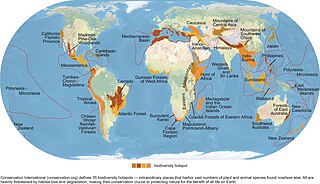
A biodiversity hotspot is a biogeographic region with significant levels of biodiversity that is threatened by human habitation. Norman Myers wrote about the concept in two articles in The Environmentalist in 1988 and 1990, after which the concept was revised following thorough analysis by Myers and others into "Hotspots: Earth's Biologically Richest and Most Endangered Terrestrial Ecoregions" and a paper published in the journal Nature, both in 2000.

Endemism is the state of a species being found only in a single defined geographic location, such as an island, state, nation, country or other defined zone; organisms that are indigenous to a place are not endemic to it if they are also found elsewhere. For example, the Cape sugarbird is found exclusively in southwestern South Africa and is therefore said to be endemic to that particular part of the world. An endemic species can also be referred to as an endemism or, in scientific literature, as an endemite. Similarly, many species found in the Western ghats of India are examples of endemism.

Ficus microcarpa, also known as Chinese banyan, small-fruited fig, Malayan banyan, Indian laurel, or curtain fig, is a species of banyan tree in the family Moraceae. Its native range is from India to China and Japan, through Southeast Asia and the western Pacific to the state of Queensland in Australia, and it has been introduced to parts of the Americas and the Mediterranean. It was first described in 1782, and is a culturally significant plant in a number of Asian countries.

Mentha longifolia, also known as horse mint, brookmint, fillymint or St. John's horsemint, is a species of plant in the family Lamiaceae. It is native to Europe excluding Britain and Ireland, western and central Asia, and northern and southern Africa.

Vachellia farnesiana, also known as Acacia farnesiana, and previously Mimosa farnesiana, commonly known as sweet acacia, huisache, casha tree, or needle bush, is a species of shrub or small tree in the legume family, Fabaceae. Its flowers are used in the perfume industry.
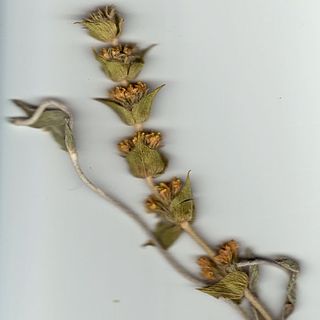
Sideritis, also known as ironwort, mountain tea, Greek tea and shepherd's tea, is a genus of flowering plants known for their use as herbal medicine, commonly as a herbal tea. They are abundant in Mediterranean regions, the Balkans, the Iberian Peninsula and Macaronesia, but can also be found in Central Europe and temperate Asia.

Astragalus mongholicus, synonyms including Astragalus propinquus and Astragalus membranaceus, commonly known as Mongolian milkvetch in English; 'Хунчир' in Mongolian; huáng qí, běi qí or huáng huā huáng qí, in Mongolia, is a flowering plant in the family Fabaceae. It is one of the 50 fundamental herbs used in traditional Mongolian medicine. It is a perennial plant and it is not listed as being threatened.
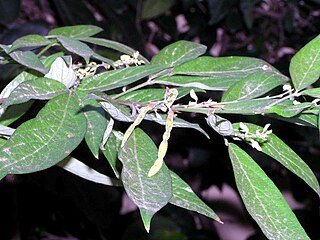
Ohwia caudata, formerly placed in the genus Desmodium, is a deciduous nitrogen fixing plant in the family Fabaceae. It is found in India, China, Taiwan and other parts of Asia. The shrub grows to a height of about 1.5 m tall. It is related to Arthroclianthus, Nephrodesmus and Hanslia. The leaves and roots of the plant are used as an insecticide.

Köpetdag Nature Reserve is a nature reserve (zapovednik) of Turkmenistan.
Millettia leucantha or sathon is a species of plant in the legume family, Fabaceae. It is a perennial flowering tree native to Indo-China – Cambodia, Laos, Myanmar, Thailand, and Vietnam – as well as Bangladesh and southern Yunnan province in China.
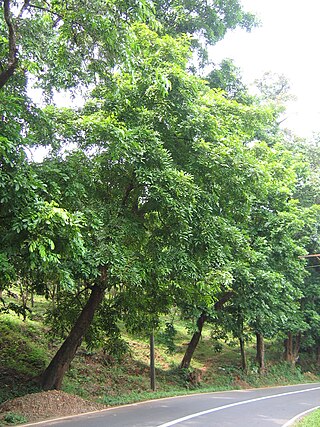
Xylia xylocarpa is a species of tree in the mimosoid clade of the subfamily Caesalpinioideae of the family Fabaceae.

Sphaerophysa salsula is a species of flowering plant in the legume family known by the common names alkali swainsonpea, Austrian peaweed, and red bladder-vetch. It is native to Asia but it is known in many other parts of the world as an introduced species and often a noxious weed. It grows in cultivated land and disturbed habitat, easily tolerating alkaline substrates. It is commonly seen in areas where alfalfa is grown, because the seeds of the two species look similar and the weed seed is easily imported with the crop seed.

The flora of North Korea has much in common with that of other areas of the northern hemisphere. 2898 species have been recorded, of which 14% are endemic. Four are classified as threatened.
Quercus kotschyana is a species of oak endemic to the mountains of Lebanon. It is placed in subgenus Quercus, section Quercus.


















